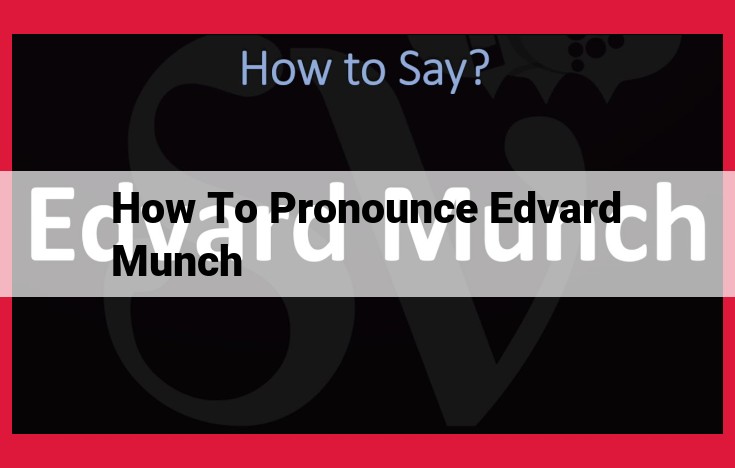
How To Pronounce Edvard Munch: Expert Guide For Accurate Articulation
To pronounce Edvard Munch's name, begin with "M" (IPA: /m/), then "u" (IPA: /u/), and "nch" (IPA: /ŋk/). In Norwegian, pronounce "e" (IPA: /ɛ/) as a short "e." In English, the name is often pronounced with a long "e" (IPA: /i/). Avoid mispronouncing it as "Munch" (IPA: /mʌntʃ/) or "Munsh" (IPA: /mʌnʃ/). For assistance, refer to online resources like recordings or videos that demonstrate the correct pronunciation.
Edvard Munch: A Master of Expressionism
Edvard Munch, an iconic artist of the late 19th and early 20th centuries, left an indelible mark on the art world with his haunting and evocative paintings. Born on December 12, 1863, in Løten, Norway, Munch's life was marked by both personal tragedy and artistic brilliance.
Growing up in a family shadowed by illness and loss, Munch's early years were shaped by the deaths of his mother and sister from tuberculosis. These experiences deeply affected his psyche, instilling in him a sense of existential angst and melancholy that would later permeate his art.
Munch's artistic journey began at an early age. He studied at the Royal School of Art in Oslo, where he developed a keen interest in the emerging trends of impressionism and post-impressionism. However, it was not until his travels to Paris and Berlin that Munch's style truly blossomed. In these artistic hubs, he encountered the works of Vincent van Gogh and Paul Gauguin, whose bold colors and expressive brushstrokes inspired him to push the boundaries of traditional painting.
Edvard Munch: Linguistic Connections
Norwegian Heritage Runs Deep
Born in Norway in 1863, Edvard Munch's native tongue was Norwegian. He was fluent in the language, using it in his personal life, writing, and artistic pursuits. Norwegian culture and landscapes heavily influenced his iconic artwork, which often depicts the emotional and psychological states of human beings.
Embracing Multiple Tongues
Beyond Norwegian, Munch also had a keen interest in languages. He studied German, English, and French, becoming proficient in all three. His exposure to these languages broadened his perspective and enriched his writing and artistic vision.
Exploring Linguistic Echoes
Munch's writings and artworks reveal traces of linguistic influences. His use of symbolism, mood, and introspection aligns with the Romantic movement, which originated in Germany. This influence is particularly evident in his writings, which often explore the darker, introspective nature of human existence.
A Tapestry of Language
The multiple languages spoken by Munch intertwined in his creative process, enriching his palette of expression. Norwegian provided the foundation, while German, English, and French added nuances and complexity to his work. This linguistic tapestry contributed to Munch's unique and enduring legacy as an artist and thinker.
Pronouncing the Name of Edvard Munch
If you're an art enthusiast, you've likely come across the iconic painting "The Scream" by the renowned Norwegian artist, Edvard Munch. While his artwork evokes strong emotions, pronouncing his name can pose a challenge. Let's delve into the correct pronunciation and avoid any linguistic mishaps.
Norwegian Pronunciation:
In Norwegian, Munch's name is pronounced "_ed-vard_ mungk". The emphasis falls on the first syllable of each word. The "u" in "Munch" is pronounced with a short, rounded sound, similar to the "u" in "put". The "g" at the end is pronounced softly, like in the word "bag".
English Pronunciation:
In English, Munch's name is commonly pronounced "_ed-werd munk_. The emphasis remains on the first syllable of each word, but the pronunciation is slightly anglicized. The "u" in "Munch" takes on a more open sound, similar to the "u" in "cup". The "g" is often omitted, giving the name a softer ending.
Common Mispronunciations:
Two common mispronunciations of Munch's name include:
- "_ed-werd mungk_: This pronunciation mistakenly emphasizes the second syllable of "Munch" and mispronounces the "u" as in "hug".
- "_ed-vurd_ or _ed-vert mungk_: These mispronunciations stem from misinterpreting the Norwegian pronunciation and incorrectly pronouncing the "d" as a "v" or "t".
Tips for Pronunciation:
- Practice: Repetition is key. Practice pronouncing Munch's name aloud several times to familiarize yourself with the sounds.
- Listen to Native Speakers: Listen to recordings or videos of Norwegians pronouncing the name to get a sense of the authentic pronunciation.
- Pay Attention to Letter Combinations: Be mindful of the letter combinations "ch" and "ng", which have specific pronunciations in Norwegian.
- Use Phonetic Transcriptions: Refer to the International Phonetic Alphabet (IPA) for an accurate representation of the sounds.
Related Resources:
- Pronouncing Munch's Name (YouTube video)
- Norwegian Pronunciation Guide (Norwegian University of Science and Technology)
Related Topics:
- Powering Input Devices: Optimizing Energy Efficiency For Keyboards, Mice, And Buttons
- Auschwitz Pronunciation: Honoring Holocaust Victims And Preserving Their Legacy
- Pronouncing “Meniscus”: Regional And Medical Variations
- Master The Pronunciation Of “Quintessentially”: A Comprehensive Guide
- Ghanaian Language Pronunciation: A Guide To Accurate Pronunciation With Tools And Resources